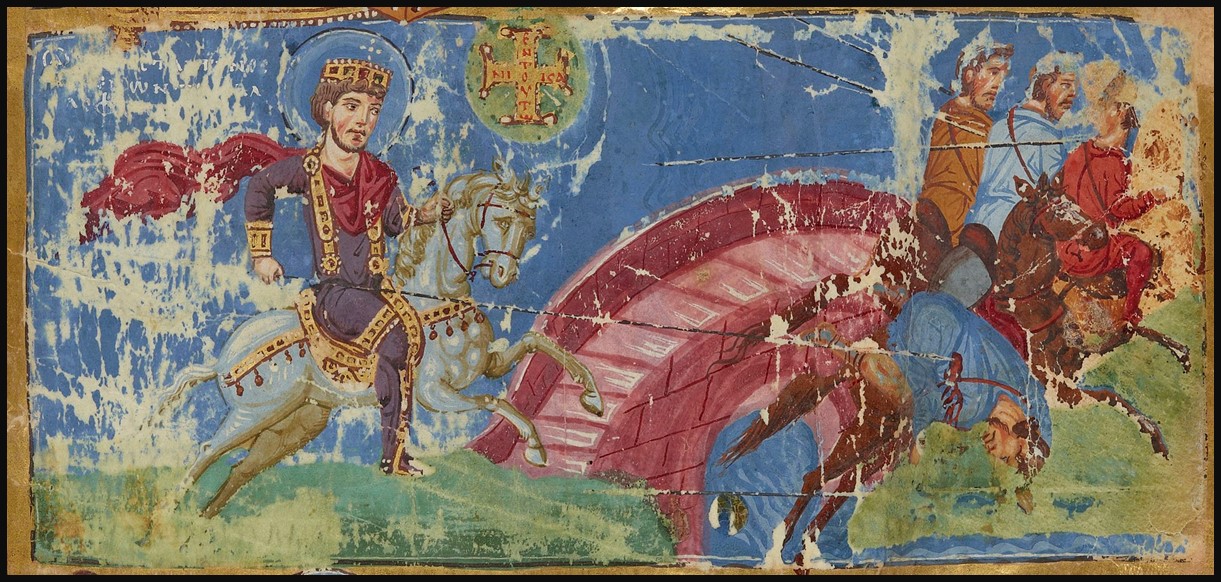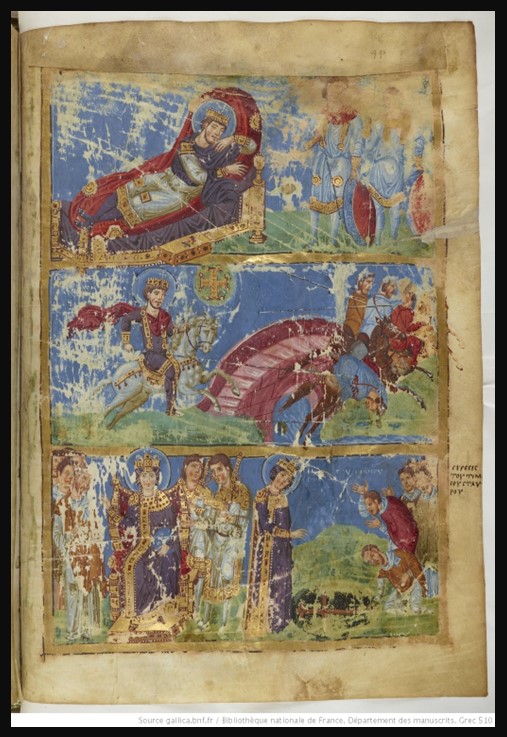
And while he was thus praying with fervent entreaty, a most marvelous sign appeared to him from heaven, the account of which it might have been hard to believe had it been related by any other person. But since the victorious emperor himself long afterwards declared it to the writer of this history, (1) when he was honored with his acquaintance and society, and confirmed his statement by an oath, who could hesitate to accredit the relation, especially since the testimony of after- time has established its truth? He said that about noon, when the day was already beginning to decline, he saw with his own eyes the trophy of a cross of light in the heavens, above the sun, and bearing the inscription, IN HOC SIGNO VINCES (Conquer by this) … This phrase is traditionally associated with Constantine the Great and his vision before the Battle of the Milvian Bridge in 312. According to early Christian historian Eusebius, Constantine saw this sign in the sky urging him to adopt the Christian cross as his standard. https://www.u.arizona.edu/~afutrell/404b/euseb%20life%20c.htm
The 9th-century Byzantine illuminated manuscript known as the Homilies of Gregory of Nazianzus, housed in the Bibliothèque Nationale de France, is a particularly exquisite example of Byzantine book art and scholarship. Codex Grec 510, features a collection of selected homilies by Gregory of Nazianzus, a central figure in the formulation of the Nicene Creed and a master of Early Christian theology. This manuscript is celebrated for its aesthetic and artistic value, containing numerous illuminations that include elaborate headpieces and initial letters, which are executed in vibrant colours and gold, reflecting the sophisticated, luxurious, and highly skilled artistry of Byzantine manuscript illumination of this period. These visual embellishments not only highlight the sacred content but also serve to guide the reader’s experience of the text. The codex is a testament to the religious devotion, intellectual fervor, and artistic sophistication of Byzantine culture, providing insights into the spiritual and cultural life of the era.
Created in the late 9th century, this fine manuscript stands as a testament to the teachings of Gregory of Nazianzus, a significant theological figure from the fourth century. It was meticulously produced as an elaborate gift for Emperor Basil I, the progenitor of the Macedonian dynasty, courtesy of Patriarch Photios, a renowned scholar of Byzantium. This manuscript is distinguished by its forty-six full-page miniatures; however, less than half of these are directly reflective of the sermons it contains. Most of the artwork instead offers a visual exploration of the Byzantine court during the ninth century. These miniatures are more than mere decorations; they are profound visual essays that provide insights not captured in other contemporary records. Through careful examination, they reveal the unique capabilities of visual art to communicate complex themes and narratives distinctively different from written texts.
The 9th-century Byzantine illuminated manuscript known as the Homilies of Gregory of Nazianzus, housed in the Bibliothèque Nationale de France, is a particularly exquisite example of Byzantine book art and scholarship. Codex Grec 510, features a collection of selected Homilies by Gregory of Nazianzus, a central figure in the formulation of the Nicene Creed and a master of Early Christian theology. This manuscript is celebrated for its aesthetic and artistic value, containing numerous illuminations that include elaborate headpieces and initial letters, which are executed in vibrant colours and gold, reflecting the sophisticated, luxurious, and highly skilled artistry of Byzantine manuscript illumination of this period. These visual embellishments not only highlight the sacred content but also serve to guide the reader’s experience of the text. The codex is a testament to the religious devotion, intellectual fervour, and artistic sophistication of Byzantine culture, providing insights into the spiritual and cultural life of the era.
Created in the late 9th century, this fine manuscript stands as a testament to the teachings of Gregory of Nazianzus, a significant theological figure from the fourth century. It was meticulously produced as an elaborate gift for Emperor Basil I, the progenitor of the Macedonian dynasty, courtesy of Patriarch Photios, a renowned scholar of Byzantium. This manuscript is distinguished by its forty-six full-page miniatures; however, less than half of these are directly reflective of the sermons it contains. Most of the artwork instead offers a visual exploration of the Byzantine court during the ninth century. These miniatures are more than mere decorations; they are profound visual essays that provide insights not captured in other contemporary records. Through careful examination, they reveal the unique capabilities of visual art to communicate complex themes and narratives distinctively different from written texts.

Folio 440r of the Homilies of Gregory of Nazianzus presents a captivating artistic depiction of a pivotal historical moment: Emperor Constantine the Great at the Battle of the Milvian Bridge. This illustration is not just a simple portrayal; it is imbued with historical and symbolic significance. The scene vividly captures the dramatic and miraculous nature of the battle, which occurred in 312 AD near Rome. According to historical accounts, Constantine, on the eve of the conflict, experienced a vision that led him to adopt the Christian symbol of the Cross and the Chi-Rho on his soldiers’ shields, a decisive factor attributed to his victory. This moment is often considered a turning point for Christianity, marking its transition from persecution to imperial endorsement.
The artistry of the miniature depicting Constantine’s victory at the Battle of the Milvian Bridge transcends simple historical documentation, embodying the theological and political ideals of the Byzantine Empire at the time of the manuscript’s creation. This illustration is set against a two-tone green ground beneath a blue backdrop, where the background features are minimalist, confined only to essential narrative elements such as the Milvian Bridge itself or a monochromatic landscape. The figures, stocky with disproportionately large heads, are rendered in a style that favours either a frontal gaze or a pure profile, even as more complex poses are attempted.
Through its detailed iconography and thoughtful composition, the miniature communicates both the earthly and heavenly endorsement of Constantine’s rule and victory, providing viewers with a layered interpretation of history that is infused with divine significance. This approach creates a visual narrative that not only highlights the pivotal moment but also emphasizes themes interwoven with the broader religious and imperial ethos of the era. The strategic simplification of background elements and the stylized depiction of figures enhance the focus on the central themes, effectively marrying form with content in a portrayal rich with symbolic meaning.
For a Student Activity inspired by folio 440r of the Homilies of Gregory of Nazianzus, which depicts Constantine the Great and the Battle of the Milvian Bridge, please… Check HERE!
Bibliography: Vision and Meaning in 9th-Century Byzantium, Image as Exegesis in the Homilies of Gregory of Nazianzus by Leslie Brubaker https://www.academia.edu/49490426/Vision_and_Meaning_in_9th_Century_Byzantium_Image_as_Exegesis_in_the_Homilies_of_Gregory_of_Nazianzus and https://gallica.bnf.fr/ark:/12148/btv1b84522082/f891